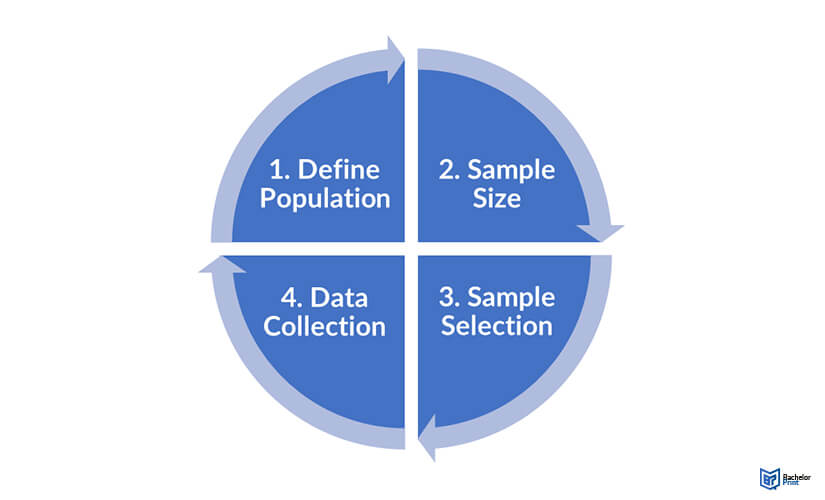
In simple random sampling, each member of the target population has an equal chance of being selected, ensuring an unbiased representation. This methodology allows researchers to make generalized conclusions about the population based on the sample, bolstering the reliability and validity of the study’s findings. Moreover, the ease of understanding and implementation makes simple random sampling a popular choice among researchers across various fields.
Definition:
Simple random sampling
Simple random sampling refers to the process of randomly picking a sample from a population without any prior defined selection process.
Since the sample selection is entirely arbitrary, simple random selection is used in research as an unbiased method of studying subsets in a given population.

When do you use simple random sampling?
Simple random sampling is utilized in the research methodology to infer confidence through internal validity and external validity. The study’s findings in simple random sampling should be trustworthy as determined by the factors under investigation and without interference from other variables, i.e., confounding variables. The results of the case study should be replicable across different studies and produce verifiable findings.
Depending on several factors, such as population size, it may be challenging to undertake simple random sampling. Some of the conditions for simple random sampling include:
Simple random sampling is used in research cases that involve a large population. It is the best approach in such instances since every sample is picked randomly. Thus, the resulting sample is assumed to be more inclusive of the main themes in the larger population. Additionally, simple random sampling can be used in cases where time and resources are readily available.
Researchers may use a combination of two probability sampling techniques based on the objectives of a case study. For example, simple random sampling may be used to construct the initial sample then systematic sampling may be applied to further distil the sample. The main types of probability sampling used in research include:
| Cluster sampling | Stratified sampling | Systematic sampling |
| This method divides a large population into smaller units called clusters. Samples are then picked from each cluster to be used for analysis. | This approach divides the population into strata or classes based on similar observable characteristics. A sample is then picked from each stratum for further scrutiny. | This method is based on an interval system of sample selection. Researchers determine the optimal sample size and then select the nth sample from a linear population for study. |
Simple random sampling: 4 Steps
The technique of simple random sampling can be broken down into 4 steps as follows:

Step 1 of simple random sampling: Define the population
Identify the population that best fits your research objectives. Outline the characteristics of the population and ensure you have access to the members throughout the course of the study as and when needed.
Step 2 of simple random sampling: Decide on the sample size
After defining the population, you should choose the sample size. You may opt to select a large sample as it is more representative. However, this usually requires more resources.
You can use standard deviation, confidence interval, and confidence level metrics. The most preferred confidence interval is 0.05, while the confidence level usually is 0.95.
If you are unsure of the standard deviation, choose a number such as 0.5, which can accommodate a range of possibilities. A sample size calculator can then be used to estimate the sample size.
Step 3 of simple random sampling: Randomly select your sample
There are two main methods:
-
Lottery method
- Each member is assigned a number; these numbers are drawn randomly from a pool.
- Computer software may be used to do the same task.
-
Random number method
- The members of the population are tagged with numbers.
- Rearchers then use different number generators to generate random numbers to be used in the sample.
- Other tools used in number generation include the RAND function in Microsoft Excel.
Step 4 of simple random sampling: Collect data from your sample
This is the final step in the simple random sampling process.
Researchers need to ensure every member selected for sampling is available and willing to participate in the study. If any members fail to co-operate or withdraw from the study, it may interfere with the accuracy of the findings.
FAQs
Simple random sampling reduces the chances of errors from pre-selected members of a sample. It is also easy to carry out as the methods are relatively straightforward.
Simple random sampling may not be applicable where the population is distributed across a large area.
Researchers may also face challenges accessing the sample group.
Additionally, simple random selection may be time-consuming and expensive over a full stop of time.
It is a probabilistic method of sample selection.
Members of a population are selected based on homogenous and heterogeneous characteristics.
Researchers use this type of sampling to study defined research goals in a large population.
The main methods used include;
- systematic sampling
- clustered sampling
- stratified sampling
They are used in their best-use scenarios from an evaluative approach based on the research issues at hand.
